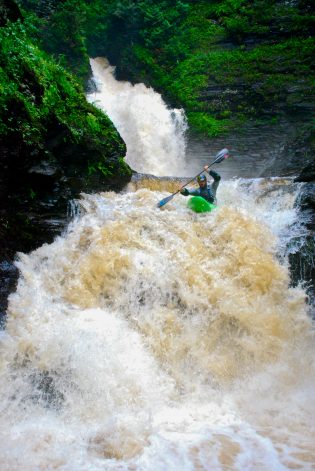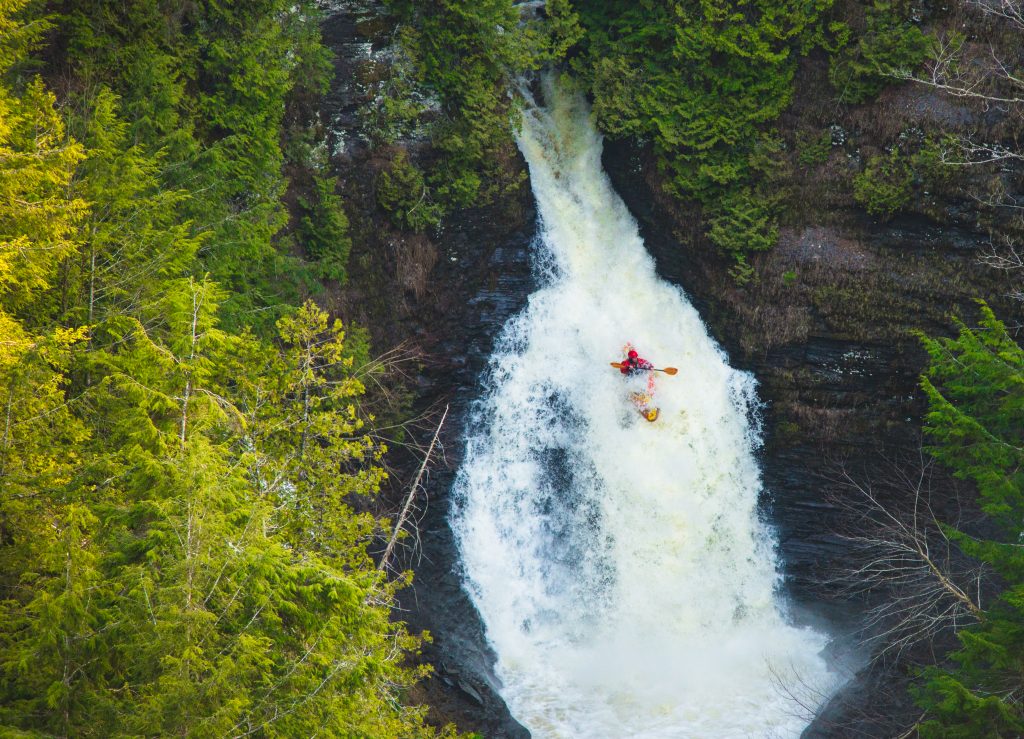A fine line separates the good from the bad, the clean from the chaos. It is a finer line still that separates good judgment from bad judgment.
And the line between life and death? That is only a thread. This would be the second time I have clung to that thread with all my strength.
When we begin pushing high water levels it is easy to give the line between good and bad a wide berth. We have learned from experience that rocks hurt, swimming sucks, and holes are terrifying. As we get better we start to forget. We know there can be bruises, gasps for breath, maybe even blood. But we forget what that feels like. Progression shaves away at that line.
The line between good and bad grows thinner. Occasionally, we are reminded of the hurt and the fear, and the line spreads out once again. But most of the time we fill our minds with the semblance of fear. We consider the hazards but do not truly believe we could suffer the consequences. If we did how could we dare take the risk?
As we continue to succeed we are encouraged to shave that line even thinner. Our perception of risk shrinks. Our perception of skill grows. The line becomes magnified. The frayed edges giving way to chaos seem far away. We make playgrounds out of water falling off cliffs. We play a game of inches. Despite our best efforts we feel invincible.
Imagine for a moment the river you are most familiar with. Each rapid should come to mind clearly, perhaps on a perfect day with optimal water levels, warm weather, and sunshine. Hold that in your mind and run through the entire stretch. Take your time. Enjoy it.
Nothing bad happened right? All you saw were perfect lines, high fives, and takeout beers. This is when the line is at it’s thinnest.

Brokeback Gorge in New York is among my greatest accomplishments. An instant classic with big drops, mind blowing scenery, and just enough commitment to make it feel real. I can say with confidence I have run it more than anyone. I was also the first to run it, somehow convincing Taylor Krammen to plunge off an unscoutable, unportageable forty-five foot waterfall with me.
What we found on that first descent was impossible to forget. Jagged vertical walls rising straight from the riverbed, sinuous slides wrapping around blind corners, and drop after drop falling away into the gorge. Each time we arrived at a horizonline, we would peer over the edge, hesitant to believe we could make further progress. It seemed impossible that so many quality rapids could unfold before us without any caveats. The region had already been scoured by whitewater addicts with more tenacity than I for over a decade, and the general attitude within the community was that if something had not been run already there was probably a reason.
As we descended into the heart of the gorge, a hallway of rock and water less than eight feet wide ending in the forty-five foot waterfall, it became clear the reason this section hadn’t been run was simply that no one had looked.
After the first descent, we reflected on the possibility for carnage in the gorge. The reality was chilling. Once beyond the first drop there are virtually no opportunities to scout, and fewer to escape. A piece of wood lodged anywhere in the gorge could be fatal. A swim…I didn’t want to consider it. I pleaded with people to respect the consequence of carnage in this place. “Treat every descent as a first descent” I said. How easily we forget.
The water was high, maybe even higher than I thought. But I imagined nothing but perfect lines through the entire run. Extra flow would only pad out the landings on big drops. I imagined myself pioneering the river a second time, this time finding the upper limit of what could be considered runnable. Especially tantalizing was the thought of a particular photo finally capturing the essence of the river.
The most puzzling thing is the absolute confidence I felt as I pulled that last stroke over the edge. I remember thinking “This is going to be sick.”
Then my world went black.
I tried to roll. I tried to roll again. And again. I felt my boat bouncing off the narrow canyon walls and knew my options were running out. Terror consumed me just as it had the first time I learned the feeling of lungs burning for air. And my declaration from the past flashed in my mind: don’t fucking swim.
Too late. In the instant my breath ran out the line between good and bad became the thread between life and death. Decades of hydrodynamic theory fell short when matched against the entropy of a perfect hole. My best dive only landed me at the peak of the recirculation. My tightest cannonball only brought me closer to the seam.
Call it willpower. Call it stubbornness. Call it entitlement. I tucked and tucked again, believing I might bounce myself along the river bottom to relative safety. Give me rocks. Give me thorny tree branches. Anything would be better than this tumbling dingy yellow and blackness. This is not the way I deserve to die. This is not the way I deserve to be remembered.
My hands flailed while my lungs burned. I pulled my knees to my chest but I continued to recirculate.
Finally I was able to catch a faltering breath of air. Water hitched in my throat. My flailing hands smacked against my boat, it too finding stasis in chaos. I latched on believing the combined mass might project us from the violence. It only allowed me a more realistic vantage of my situation. My paddling partner Dustin Caza had already passed me. I wasn’t going anywhere without help.
I gulped another breath of air. My arms were heavy with exhaustion. My feet slipped and scrabbled against the bobbing kayak as the hole snatched at them. And the cold was seeping in. In my mind’s eye I could see that thin thread of life leading downstream. Time was running out.
As soon as my feet made solid contact with plastic I lunged outward, diving with all my might towards my friend staring helplessly from downstream. The hole’s current ripped at my feet. I hovered on the boil line for a half second willing years of competitive swimming experience to emerge from distant memories. At last the water surrounding me was moving downstream. I could surrender.
Once I was stable Dustin took off in search of my paddle. I expected my boat to surge free and for us to continue through the only logical exit of the gorge-over the falls. I remained clinging to the vertical cliff walls, waist deep in surging water, with only a narrow projection of rock for my feet to balance upon. I was only feet from the place I had nearly abandoned all hope. As I watched my kayak gently bob in the seam I remembered that the stable holes are the worst. This one was a near perfect drowning machine.
After twenty minutes I gave up. The kayak wasn’t going anywhere on its own, and Dustin had been out of sight for far too long already. I jumped into the current pinballing between rock walls for a few feet before catching a shallow spot and regaining my feet. Dustin had stopped just around the corner, realizing the folly of chasing gear alone in a flooded slot canyon.
He had already secured his boat to one of the few slopes rising gradually enough out of the gorge to support trees when I arrived. Looking up the thread of life flashed before me once again. The wall was steep, and drifts of snow clung to it in pockets, but there was a way. I burrowed my fingers through the crumbling shale into pockets of moss, dirt, and tree roots. I ground my feet into the actively eroding walls. The clatter of falling rocks mingled with the rush of water and our heavy breathing. In the last 20 feet, the walls approached vertical once again. Dustin was able to climb up and throw me a rope for the last pitch.
I remember staring hollow-eyed into the canyon still not fully registering what had happened over the last hour. The line between good and bad had grown so thin I did not realize when I had crossed it. In this case, the thread between life and death had been surrounded by razors: vertical walls, a flooded river, and an ultra retentive hole. I just got lucky.
It is easy to forget how thin we spread our lines, especially when it feels like you are on fire. Just remember the river has no trouble putting out flames.

Eric Adsit grew up in the rivers and rolling hills surrounding Lowville, New York. Photography, film production, and writing often interrupt his focus on whitewater kayaking. He’s still trying to shake the nickname The Beaverator Kid
Leave a Reply